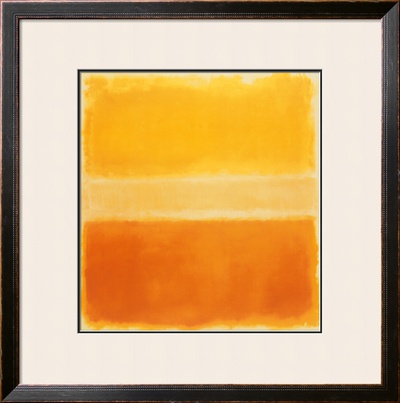(Fair warning: those "sporadic ramblings" I allude to in the blog header? Here they come.)
The other day in English class, we got into some pretty heated discussions about the function of poetry and how its very essence is being defined and re-defined by different literary circles/groups/college English classes. This overarching question (what constitutes poetry? what makes it "good" or respectable or legitimate?, etc) was brought on in part, I believe, by trying to analyze some postmodern poetry using "classical poetry analysis" techniques and the frustrations some of us felt when trying to approach the works of someone like GC Waldrep or Lyn Hejinian, whose poems clearly defy many of the constructs or definitions of more traditional poetry.
Long story short, it got me thinking about postmodernism in other art forms (specifically painting) and a study I remember stumbling across in which critics were unable to differentiate between works by artists like Rothko and Pollock, and works created by 5-year-olds. I brought this point up in class, and received a response along the lines of "Well, maybe the significance of the paintings of these modern artists has to do with the artist's conceptual context of the work... the deeper ideas that influenced these works of art are what make them important..." Can this be implying that the physical painting is secondary to the artist's explanation of the ideas or concepts influencing the creation of the work? It makes me wonder: is there a point where the importance of the creation process eclipses the significance of the physical, literal work of art (be it painting, sculpture, poem) itself? Furthermore, have postmodern writers like Hejinian already reached or surpassed that point?
I know that when I first approached Hejinian's My Life, I did so before doing background research on the concepts she has become known for. Without any context of the ideas behind her creative method, I had a terribly difficult time making heads or tails of the book's poems... and I still don't have concrete answers to any of the musings contained in this post, but here's something worth noting: the book's inaccessibility and the questions it raises are really making me think. That simple fact, in and of itself, might be enough for me to value My Life as a meaningful contribution to the world of literature (and as a work of art in a broader context). For now, though, the jury's still out on this one...
One of my favorite Mark Rothko paintings: "Yellow and Gold" (1956)

Daniel--that these works of art are making you think is the point!
ReplyDeleteEngagement of the reader in the creation of the text is a goal of most language poets. Rather than treating the text as a precious "object" to be revered or decoded or owned, these writers see the text as something produced collaboratively by reader and writer. Thus discussion of the work, or response to the work, is not just to show that you've decoded it, but rather that you've participated in creating its meaning.
So . . . is the concept more valuable that the individual work? Is the process more important than the product? Perhaps the question is one of value: what kind of value? and to whom?
In any case, a lovely Rothko. Have you seen any originals? They are huge and lovely. The colors and proportions sing. But I think they, like Hejinian's My Life, invite the reader to be a co-creator of meaning, even as they still retain a sense of originality, beauty, and skill.
Ok, if I could edit my post, I'd take out that second "lovely" in the last paragraph;-)
ReplyDeleteDear Daniel,
ReplyDeleteOur explorations with postmodern poetry in class have also led me to ponder a comparison between contemporary art and contemporary poetry. In the past I've been pretty quick to judge and discredit what I viewed as bizarre modern art that I just didn't get. When we first started reading postmodern poetry I felt a similar response. When I was confronted with jarring forms and seemingly indecipherable groupings of words, I again judged the unfamiliar art form wasn't worth my time. With more exposure to postmodern poetry, I've come to realize most of what keeps me from appreciating the art form is my general lack of understanding of the new age style. You're right to question whether using classical poetry analysis techniques is appropriate for this new style of poetry. It wouldn't make sense to use an old DC meter to measure modern AC current, would it?
Because the goal of the postmodern poetry is so different from classical poems, do you think we could go as far as classifying postmodern poetry as something other than poetry? I sometimes wonder whether it should be included in the same category as some of the classic poems we've read. I suppose that's for the What Is Poetry? paper.
Sincerely,
John
I really like the comment which you made in class about the paintings. Yes, it seems that is an important point, that the reason behind the work is sometimes more important than the piece. Although one might say that is necessary for this piece to be used to better convey that reason.
ReplyDeleteI think that this is a really significant topic for discussing what poetry is and is not and I have used it as inspiration for part of my report.
I think it's very interesting to consider these two separate factors of modern art. It reveals something about modernism, I think, and how form and content are interacting with one another these days. A very good idea to have and observations to make.
ReplyDeleteDo I have something deep and meaningful to say? Not really. Just wanted to say that I like the painting as well.
ReplyDelete